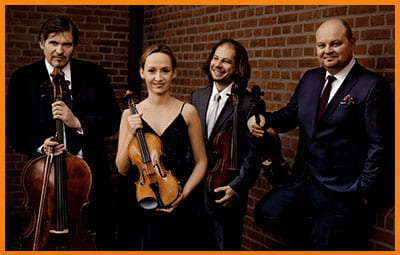The chic Ace Gallery on Wilshire Blvd. just east of Beverly Dr. played host to the Szymanowski Quartet on Saturday evening, February 20—the Polish ensemble’s only Los Angeles appearance in their 8-concert California tour this February. The gallery offers infrequent but fantastic concerts of chamber music, regular guests in recent seasons being the Takács and Emerson String Quartets. Founded in Warsaw in 1995, the Szymanowski Quartet boasts an impressive resume of recordings, awards, and concert appearances—and their performance did not disappoint.
The evening began with Four Polish Renaissance Chorales by Wacław of Szamotuły (1520-1560), in a simple and tasteful arrangement by the Szymanowski Quartet. The chorales served as a fine aperitif, played with sparse vibrato, light bow strokes and a certain period consciousness. The quartet assumed its proper attire for the rest of the program, presenting string quartets by Haydn, Bacewicz, and Dvořák. The violinists in the group alternated playing first or second violin, and the cellist sat on the inside of the semicircle with the violist sitting on the outside. The Szymanowski Quartet’s performance was fantastic. Led by cellist Marcin Sienawski and violinist Grzegorz Kotow, the group played with daring abandon and freedom, never losing sight the of the music’s character or intent. Unlike so many American string quartets who focus first on technical perfection and beauty of tone, leaving exploration of musical character a distant second, the Szymanowski Quartet went straight to the heart of the works, especially in the case of the Bacewicz (String Quartet No. 4) and Dvořák (String Quartet in A-flat, opus 105). The performers’ old-world understanding brought these works to life for the posh and trendy Beverly Hills audience, an unlikely but not unprecedented meeting of Central Europe’s musical soul with the extravagant glitz of la la land…
There is something truly special about the string quartet. Solidified and guaranteed posterity by Haydn, the genre quickly became an indispensible province on the map of classical music. As with any performing art, written music expires quietly without a willing and capable medium to realize it, and this is especially the case with the string quartet. Luckily Dvořák and Bacewicz, for the time being, have nothing to worry about—their art finds the highest representation in the coordinated hands of the Szymanowski Quartet.
